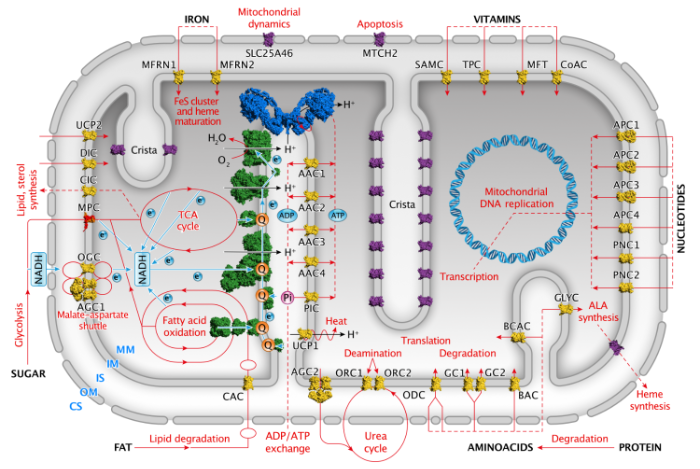A large number of transport proteins are required for the translocation of molecules across the impermeable inner membrane of mitochondria to link the pathways of the cytosol with those of the mitochondrial matrix. The transport processes are key to our understanding of mitochondrial and cellular physiology, as well as human disease.
Figure Schematic representation of the role of transport in mitochondrial and cellular metabolism.
The molecular identities of many mitochondrial transport proteins involved in metabolism and other cellular processes have not been established. Amino acids must be imported into the mitochondrial matrix for protein synthesis, interconversions or deamination reactions, yet the vast majority of amino acid transporters have not been identified. For the synthesis of iron-sulphur clusters and haem, mitochondria need to import a source of sulphur and to export aminolevulinic acid. Transporters for crucial cofactors such as NAD, biotin, pantothenic acid and pyridoxal phosphate or their precursors and derivatives have not been identified either. The transporters of guanine nucleotides for the synthesis of DNA and RNA and antioxidants for protection against reactive oxygen species are also unknown. There are 53 different members of the mitochondrial carrier family encoded by the human genome, but more than half have no assigned function [1] [2]. There are also other membrane protein families involved in transport in mitochondria, for example the mitochondrial pyruvate transporter [3] [4] and mitochondrial ABC transporters [5] [6].
One of the major aims of the group is to identify new transport proteins and to understand their role in physiology and disease.
REFERENCES
-
Ruprecht JJ & Kunji ERS (2020)TIBS, 45, 244-258
- Kunji ERS & Robinson AJ (2010)
Coupling of proton and substrate translocation in the transport cycle of mitochondrial carriers.
Curr Opin Struct Biol 20, 440-7 - Herzig S, Raemy E, Montessuit S, Veuthey J-L, Zamboni N, Westermann B, Kunji ERS & Martinou J-C (2012)
Identification and functional expression of the mitochondrial pyruvate carrier.
Science 337, 93-6 - Bricker DK, Taylor EB, Schell JC, Orsak T, Boutron A, Chen Y-C, Cox JE, Cardon CM, Van Vranken JG, Dephoure N, Redin C, Boudina S, Gygi SP, Brivet M, Thummel CS & Rutter J (2012)
A mitochondrial pyruvate carrier required for pyruvate uptake in yeast, Drosophila, and humans.
Science 337, 96-100 - Srinivasan V, Pierik AJ & Lill R (2014)
Crystal structures of nucleotide-free and glutathione-bound mitochondrial ABC transporter Atm1.
Science 343, 1137-40 - Shintre CA, Pike ACW, Li Q, Kim J-I, Barr AJ, Goubin S, Shrestha L, Yang J, Berridge G, Ross J, Stansfeld PJ, Sansom MSP, Edwards AM, Bountra C, Marsden BD, von Delft F, Bullock AN, Gileadi O, Burgess-Brown NA & Carpenter EP (2013)
Structures of ABCB10, a human ATP-binding cassette transporter in apo- and nucleotide-bound states.
Proc Natl Acad Sci U S A 110, 9710-5


